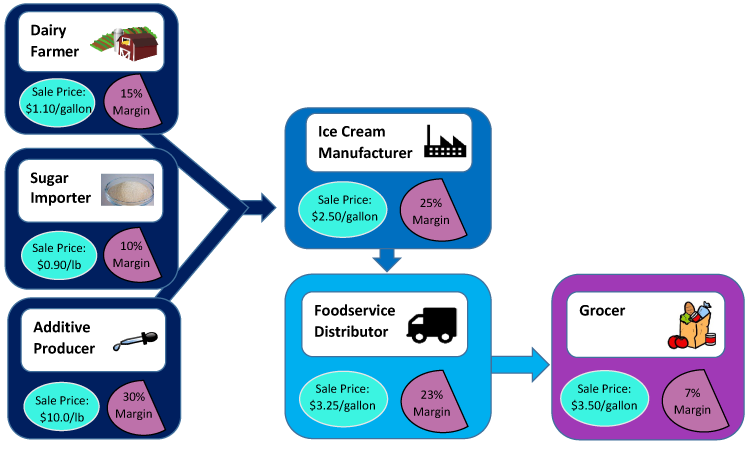 Generally speaking, value chain analysis typically includes two types of ventures:
Generally speaking, value chain analysis typically includes two types of ventures:
- Firm value chain analysis (often referred to as Porter Value Chain Analysis) examines internal company practices and their optimization relative to creating value for customers.
- Industry value chain analysis involves examining the various stages of a product’s production, from raw material procurement all the way through the final purchase by end-users.
While internal analysis can be a helpful tool for improving margins, industry-wide analysis can assist companies with a broad range of business-critical activities, such as evaluating and planning potential mergers and acquisitions, exploring new markets and improving competitive positioning, in addition to profit margin optimization. For our discussion, we will be focusing on industry value chain analysis.
Understanding the Industry Value Chain
A value chain includes profit and cost considerations for each step in a product’s lifecycle, including raw material sourcing/production, manufacturing concerns and the characteristics of the final sale to end-users. During value chain analysis (VCA), each step (or “node”) of a product’s value creation is evaluated. These examined nodes include factors such as the sourcing of raw materials, costs associated with production and distribution, and the characteristics that drive customers’ willingness to pay for the final product. Qualities of each node impact the total costs and expected margins of the final delivered product.
VCA is often used to identify opportunities for increased profit through the recognition of more effective cost control, pricing, product positioning and/or distribution strategies. At each node of the value chain, market participants are actively producing goods or offering services, while simultaneously making numerous choices that directly affect their profit margins.
Industry Value Chain Example
The various nodes of a value chain are often best summarized graphically. Below you will find an introductory example of a value chain process for the production of a common food item (ice cream).
In this case, the VCA details the profitability at several different nodes in the ice cream sales process, from raw material (dairy, sugar, flavorings) production, product manufacture, distribution and the final retail sale to the consumer. At each node, market participants experience unique cost and price considerations, and perform activities that add value above the material and labor inputs utilized, yielding varying gross profit margins.

For instance, in the example above, expected gross profit margins differ significantly within and between value chain nodes. The ice cream manufacturer, foodservice distributor and additive producer have some of the highest margins. Meanwhile, the sugar importer and grocer have some of the lowest (at 10% or lower). VCA analysis could reveal additional insights, such as trade regulations that create volatility in the price of imported sugar, or how grocer margins fluctuate between major national chains.
Why Perform Industry Value Chain Analysis?
M&A / Integration
Whether assessing the potential acquisition of a competitive firm or exploring backward integration up the supply chain, understanding the value chain dynamics of your market is key to success. Upstream nodes of the value chain, such as raw material supply, may have unknown costs or be vulnerable to market fluctuations (trade tensions, unforeseen weather events, plant closures, etc).
Further, examining the factors that drive production costs can aid estimations of the potential benefit of mergers and acquisitions, particularly if the goal is to invoke economies of scale. These market dynamics are often unknown to downstream manufacturers, and can be revealed when the entirety of the value chain is evaluated in total.
New Market Entry
Before expanding a product range or entering an entirely unknown market, it is essential to have a clear understanding of the potential market’s value chain. Various factors can influence the expected profits associated with a new market, such as local regulations, the degree of market concentration in the new industry and average existing gross profit margins. The entire scope of the value chain (from raw material acquisition to final sale to end-users) will drive realized profits in the potential new market.
Additionally, information regarding the value chains of your competitors can guide estimates for average margins in the market, and common supply chain behavior.
Competitive Intelligence
VCA can assist with evaluation of competitive positioning, including current estimates of average industry margins. Competitive intelligence specific to value chains is often enlightening, with the potential to reveal more cost-effective supply chains or profitable pricing strategies. In some cases, investigating the value chain behavior of key competitors can reveal the chance to improve current margins to industry averages.
Additionally, VCA can illuminate which factors drive margins at the end-user node, and can guide product improvements that will best drive future profits. Finally, VCA can reveal the level of integration of specific supply chains, and the strategies taken by major competitors to control production costs.
Margin Optimization
Supply chains can be impacted by a variety of factors, including shifting trade patterns, industry competitive landscapes and geopolitical pressures. A well-founded understanding of the dynamics behind your current value chain can drive strategic decisions to improve sales or margins.
For example, a firm feeling the impact of changes in trade policy or tariffs can identify new supply routes to feed its production process. Additionally, when facing changes in global trade patterns, VCA can infer how necessary it is to react to trade policy given other competitors' current supply chains. In cases where value chains are particularly complex, a complete VCA can provide opportunities to examine new supply chain or distribution approaches.
How Custom Market Research Can Help
In some cases, value chain information on specific nodes is publicly available through financial disclosures, annual reports or accessible databases. However, in many instances, even when there is a wealth of publicly available secondary information, value chains may be very complex. In those cases, it can be difficult to ascertain how materials are being sourced, manufactured and sold.
Custom market research, with a particular emphasis on primary research and competitive intelligence, can illuminate the value chain at each node of interest, and provide estimates for costs, pricing and margins. Additionally, contracting with outside custom research firms ensures independent, third-party estimates and recommendations, which can be crucial for new market entry evaluation or potential acquisitions.
Where to Learn More
The analysts at Freedonia Custom Research are highly skilled in analyzing global industrial and business-to-business markets. For more than 15 years, they have been helping clients make the right decisions through hundreds of complex projects completed for many of the largest industrial companies in the world. Freedonia Custom Research has completed a variety of value chain analyses for clients across a number of industries, with support from its experienced team of dedicated research analysts. Contact us to discuss your specific research needs and to explore how we can help you achieve your strategic goals.
To access more insights, you are also welcome to download our newly published white paper "8 Steps to a Successful Voice of Market Project."
About the author: William Cochran is a Senior Research Analyst at The Freedonia Group, where he is responsible for both primary and secondary research activities, the analysis and synthesis of data, and the organization and delivery of internal and client project deliverables. He earned a master's degree in health economics from Indiana University-Purdue University at Indianapolis and a bachelor's degree in economics and anthropology from Youngstown State University.


